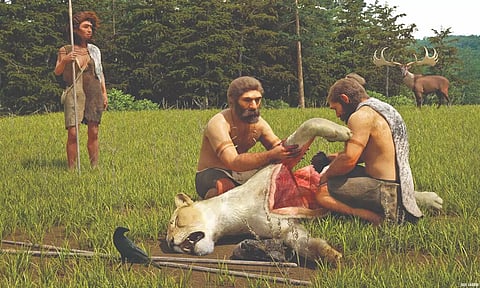

NEW YORK: Stone Age cartoon enthusiasts will recall that Fred Flintstone polished off racks of brontosaurus ribs and that Wilma Flintstone swanned around in a Siberian mastodon fur coat. As it turns out, the Neanderthals of, say, 46,000 B.C. may have had similar dining habits and tastes in daywear.
An academic paper published on Thursday in the journal Scientific Reports proposes that our long-extinct ancestors not only were the first humans to kill and butcher large predators but that they also used the hides for cultural purposes and perhaps even dressed in them.
Researchers analyzed cut marks and puncture wounds on the remains of two Eurasian cave lions unearthed 34 years apart in present-day Germany. One set of bones, an almost intact skeleton found near Siegsdorf at the foot of the Bavarian Alps in 1985, is estimated to be about 48,000 years old; the other assemblage, two toe bones and one tiny paw bone that had been embedded in a pelt that later disintegrated, was discovered in 2019 deep within Einhornhohle, or Unicorn Cave, in the Harz Mountains and dates to approximately 190,000 years ago.
Both lions lived during an era when Neanderthals were the only humans that occupied Europe; the first Homo sapiens did not arrive on the continent until roughly 42,000 years ago.
The new study addresses a foundational question in zooarchaeology: Were early hominids the hunters or the hunted? “The Siegsdorf findings provide the earliest concrete evidence of humans hunting down the formidable lion, the ultimate hunter of the animal kingdom,” said Gabriele Russo, a doctoral candidate in zooarchaeology at the University of Tübingen and the first author of the paper.
“This discovery helps to reshape our understanding of other human species’ capabilities and challenges preconceived notions about Neanderthals.”
As recently as the 1990s, Neanderthals were judged by scholars to be rock-brained scavengers too helpless to hunt on their own. Based partly on the absence of upper limb bones dug up at Neanderthal campsites, the consensus was that they eked by on the less meaty leftovers of other carnivores. But a reappraisal of the evidence showed that the bones that were supposedly missing had been shattered by the group to get at the marrow.
Neanderthals are now thought to have been more sophisticated and multitalented than imagined.
Evidence is mounting that they used a complex language and even, considering the ritual interment of their dead, some form of spirituality. They made sticky pitches to secure their spear points by heating birch bark; stalked bison, wild cattle, and straight-tusked elephants, and ambushed hibernating cave bears as the animals woke from their annual slumber.
Until now, no study had demonstrated that Neanderthals intentionally hunted large beasts of prey, much less cave lions, apex predators that ranged widely across northern Eurasia and Alaska from 370,000 B.C. to 10,000 B.C.
“We have very early indirect evidence of hunting of non-predators, although there is some debate about what constitutes hunting and when,” said Annemieke Milks, an archaeologist at the University of Reading who collaborated on the paper.